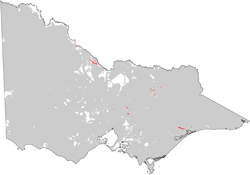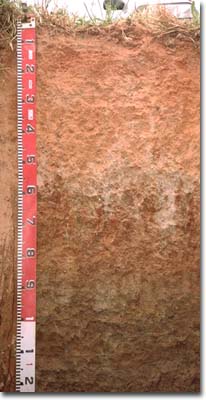Victorian Horticulture Cropping Soils - Kandosols
Back to: Victorian Horticulture Soils
Kandosols (Australian Soil Classification) lack strong texture contrast between the surface (A) horizons and subsoil (B) horizons. They are also characterised by having massive (i.e. structureless) or only very weakly structured subsoils that are often 'earthy' in appearance. Some part of the weakly developed B horizon must have a clay content of more than 15%. If the clay content is less than 15% then the soils would often then be classified as Tenosols.
Distribution
| Kandosols are not a major horticulture cropping soil and often occur on steep terrain, especially associated with granite landscapes. |  |
| Black and Brown Kandosols can occur in riverine valleys associated with recent alluvium. Red Kandosols can also occur in the northern Victorian riverine plains where they are typically associated with channel deposits of prior streams. Soil Pit Site GN23 is an example of a Red Kandosol in the East Shepparton region. Kandosols often occur in association with other soil types such as Dermosols and Tenosols and there may be some gradations between these. |  Site GN23 profile |
Management Considerations
Management strategies for all soils should include: increasing organic matter levels in the surface soil, minimising the degradation of soil aggregates and porosity, promoting the development of stable biopores, improving the calcium status of the cation exchange complex (particularly when sodium is a significant part), and breaking up any hardpans. Less frequent tillage, using less aggressive implements and working the soil at its optimum moisture content, can all assist in maintaining soil aggregation and porosity, as well as reducing organic matter breakdown.
Kandosols are mostly well drained, permeable soils. Even though they lack well developed structure the surface soils often tend to be quite deep and there is no sharp texture increase at the A/B horizon boundary. This will present few restrictions to root and water movement unless hardened (indurated) layers occur. Black Kandosols developed on alluvial deposits have higher amounts of organic matter in the soil profile and are usually more friable and well suited to horticulture.


